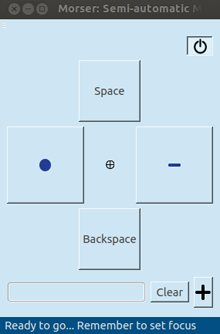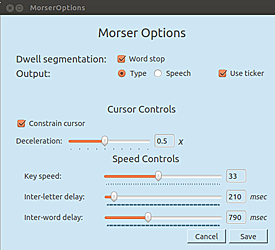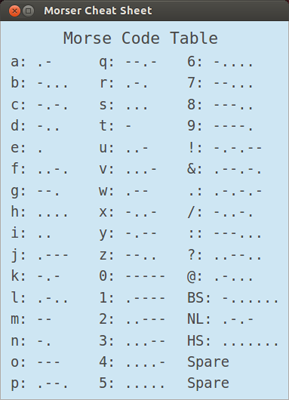Contents
Morser: Morse Code Input to Linux Systems
Overview
The Morser package enables computer operators to input text via Morse code. The user interface is designed to work when only cursor movement and single clicks are available to the user. For example, the interface works with a head tracker and a mouse switch.

Operating the interface generates Morse code, which Morser translates to text. The text is sent both to a ticker tape that is part of the UI, and to the X11 window that is in focus.
Special cursor physics are active during Morse code generation to maximize accuracy, comfort, and speed. A speed timer is available in the interface to self monitor progress.
A number of motion parameters are controlled in an options screen. A Morse code reference sheet is also built in.
Starting the Application
Morser is started via:
roslaunch morse_input morse.launch
The resulting main window may be moved to a convenient place. If the window is resized, the new size is remembered, and subsequent starts of the application will size the main window accordingly.
Operation
The Morser interface is modeled after single-paddle electronic telegraph keys. During operation, the cursor is situated inside the rest zone, the area with the crosshair between the buttons. When the cursor is moved against the dot button, a series of Morse dots is automatically generated, until the cursor is backed away from the button edge. Generation of dash sounds is analogous.
It is important to click on the intended text destination window before beginning Morse generation in the Morser window. Make sure the Morser window and the text destination window do not overlap to avoid flicker of the Morser window.
Once that destination window is selected, move the cursor into the Morser window. In order to avoid spurious input while passing over one of the buttons when moving the cursor into the rest zone, keep the left mouse button depressed during the cursor move. The button acts as a clutch that temporarily deactivates the dash and dot buttons.
Once the cursor has reached the rest zone, release the mouse button. The cursor will then be constrained to move horizontally. Morser will also prevent the cursor from penetrating into the dot and dash button areas. If moved against one of these buttons, the cursor is kept touching the respective button's edge. This constraint enables the user to 'slam' the cursor into the button edges, while keeping the return distance into the rest zone constant.
To move the cursor out of the rest zone, hold down the left mouse button before moving the cursor. While Morser is not in use, the buttons can be disabled via the virtual power switch in the upper right corner of the Morser window. This precaution is recommended to prevent text to be inserted into focused windows while moving the cursor across the Morser window.
Use of the Space and Backspace buttons is not recommended. Their use is very time consuming, and disrupts input rhythm, which is essential for speedy operation. Instead, spaces can be inserted by one of two methods:
Use a pause between Morse letters to insert a space between two words automatically. This behavior is the default, but it can be modified in the options panel (See #OptionsPanel section below).
Use the fusion of the H and S Morse signals into a single sequence of seven dots: four for H, and three for S (ligature). HS stands for Horizontal Space.
Backspace can similarly be produced via BS (dash-dot-dot-dot dot-dot-dot)
Options Panel
A number of operational parameters can be adjusted in the Options Panel, which is reached either via the Edit menu, or the keyboard shortcut cnt-O (that is oh as in option). Hovering over any of the elements raises a short tooltip that explains the purpose of each widget.

The options panel consists of several sections. The Dwell segmentation section's Word stop checkbox controls whether or not pauses beyond a certain threshold between Morse letters automatically insert a space. When a long enough pause is detected, the crosshair in the rest zone briefly blinks yellow. The length of the pause is controlled by the inter-letter delay slider of the options panel.
The Output section controls where decoded text is sent. The ticker tape inside the main Morser window can always be targeted in addition to other destinations. Outside the Morser window, options are to have the text sent to the currently focused screen window, or to have it sent to SpeakEasy for text-to-speech conversion.
The Cursor constraint section controls cursor behavior. The default of having the cursor be constraint to horizontal travel inside the rest zone may be altered by unchecking the Constrain cursor checkbox. The Deceleration slider controls cursor speed inside the rest zone. It is generally recommended to slow the cursor in the zone. The slider controls the factor by which the cursor is slowed, relative to the current mouse cursor speed as set in the operating system settings.
The Speed Controls section holds three controls. The Key speed adjusts the speed at which dots and dashes are generated while the cursor abuts the respective dot or dash button. The Inter-letter delay controls the threshold of time lapse between successive dots or dashes that has Morser conclude that one Morse letter has been entered to completion. For example: a Morse dot encodes the letter 'e', while dot-dot encodes the letter 'i'. Morsing the sequence 'ei' requires a brief pause between the first dot and the following sequence of two dots. This pause is the inter-letter delay. If the operator does not provide this pause, then Morser interprets the total of three dots as a single letter 's'. The inter-letter delay is measured in milliseconds.
The Inter-word delay is only relevant when Word stop is turned on. The slider's units are milliseconds, and its setting determines when Morser concludes that an inter-word space is to be inserted.
All options settings are permanently stored below the user's home directory, in $HOME/.morser/morser.cfg.
Speed Timer
Clicking the plus sign on the Morser window opens a Morse input timing tool. The tool measures words per minute, where a word is any sequence of five Morse letters or spaces. To start the timer, click the TimeMe button. The crosshair will begin to blink, indicating that the timer is cocked. Timing only starts with the beginning of the first Morse letter.
The timer can be temporarily suspended by holding down the left mouse button.
Morse Reference Table
The View menu allows users to raise a Morse code reference table. The keyboard shortcut cnt-m also exposes the table. All Morse letters in the table are standard, except for horizontal space and backspace.

MorseChallenger for Learning Morse Keying
The MorseChallenger program is a simple game that comes with Morser. Users select a level of difficulty, and the characters they have already learned to key. Random selections of these characters will then descend from the top of the MorseChallenger window. If they reach the bottom of the window, they 'explode.' However, any letter that is keyed in as Morse code before the letter reaches the bottom of the MorseChallenger application window is 'defused' and disappears.
Difficulty level settings include the speed at which the letters descend, and the number of letters in flight at the same time. To start MorseChallenger:
rosrun morse_input morse_challenger.py
Note: Make sure that:
the MorseChallenger window and the Morser window do not overlap on the screen, and as usual,
that you make MorseChallenger the active window before beginning to Morse. That is, click somewhere on the MorseChallenger window surface before moving the mouse to the Morser window to start morsing.
Use With Head Trackers
The Tracker 2000, and presumably other head tracker models, calibrate the cursor position relative to head position when the head is turned while the cursor is prevented from moving. For example, when the cursor is flush against the right edge of the display, where it cannot move further, users can continue to turn their heads to the right. This motion effects a re-calibration of the cursor movement to the left.
Unfortunately, pushing the cursor against the Morse button edges triggers the same calibration. To avoid this unwanted effect, the operator should avoid pushing the cursor hard into the buttons. That is as much as possible, the head should stop moving once the cursor reaches the desired button edge.
When the cursor does get out of calibration from Morse entry, press the right mouse button, and turn your head to the position that has you expect the cursor to hover around the crosshair. Once the right mouse button is released, the head tracker calibration is corrected.
